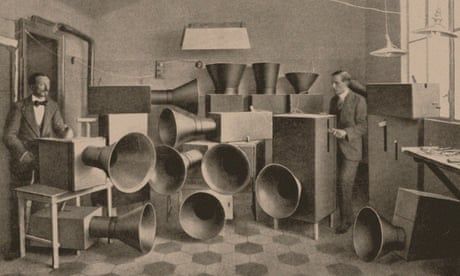
With their funnel-like hooters and cupboard-like shapes, they looked bizarre, sounded wild and left audiences baffled. Now, more than 100 years on, Luigi Russolo’s orchestra of futurist machine instruments is back …
Today it is the venerable home of the English National Opera, but back in June 1914, the London Coliseum welcomed an act quite unlike anything seen there before or since: an orchestra of futurist noise machines. With their aggressively boxy chassis and funnel-like hooters, they resembled a flock of cubist birds or an artillery battery designed by Tove Jansson. Even stranger were the sounds they made. Each one had its own onomatopoeic name and in combination they evoked more a diagnostic toolkit for gastroenterologists than a set of musical instruments: there was the rumbler (or rombatore), the gurgler (gorgogliatore), and, most disturbingly of all, the howler (ululatore). It was a pretty far cry from The Pirates of Penzance.
All things considered, the response of the London audience 110 years ago was only to be expected. An instrument called the scoppiatore (or “burster”), supposed to imitate the sound of a combustion engine, prompted cries of “Change ’ere for Peckham!” The gorgogliatore prompted one wag in the stalls to cry out, “Take the baby home, can’t you?” But today those machines are widely recognised as the opening towards an entirely new conception of what music can be. Genres like sound art, noise music, musique concrète, and industrial techno all trace their origins back to that motley assortment of rumbling, gurgling, howling boxes. The original instruments are now long lost, probably destroyed during the second world war. But an ambitious project to rebuild the futurist instrumentarium will see their replicas return to the London stage this week in a concert featuring new works specially composed for them by Pauline Oliveros, Peter Ablinger, Tony Conrad, and others.
Continue reading...